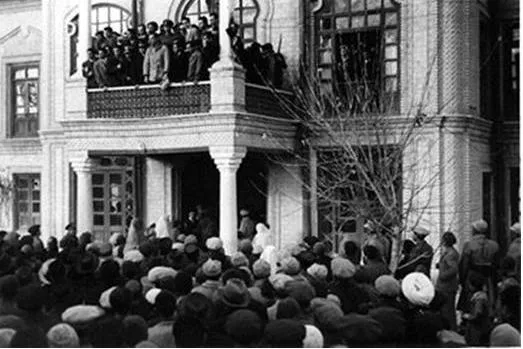
Officially, most historians place the start of the Cold War in 1947, when the Truman Doctrine was announced, promising support for countries under threat from the Soviet Union (1). Unofficially, many earlier events hinted at the approaching standoff between the United States and the U.S.S.R. Today we will look at one of the earliest scuffles between superpowers in the postwar years. It happened in Iran.
During WWII, Iran was invaded and occupied by Great Britain and the Soviet Union, becoming a vital supply route for the Allies (2). With the British controlling the south and the Soviets occupying the north, a withdrawal deadline was set for March 2, 1946. The Soviet Union, however, had other plans.
In the northwestern corner of Iran, sharing a border with the U.S.S.R., was a region called Iranian Azerbaijan, populated by a non-Persian Turkic speaking minority, the Azeris. The Soviets began planning and organizing a separatist coup in July of 1945, and began funding a front group, the Azerbaijan Democratic Party, or ADP (3). With help from Soviet troops, the police stations were seized and roads blocked. On December 15, 1945, the People's Republic of Azerbaijan was established, with its capital in Tabriz (not to be confused with the Azerbaijan Socialist Republic, located just to the north of Iran and already belonging to the Soviet Union). Iran soon asked Britain and the United States for help reclaiming the breakaway province. The U.S. insisted that Soviet troops clear out and let Iran restore order, but Soviet leader Joseph Stalin had no intention of relinquishing the region, and more importantly, its oil reserves.
American president Harry S. Truman worried privately about a possible war with Russia as early as December(4), and moved the USS Missouri to the Mediterranean in March of 1946, when the Soviets failed to pull out of Iran by the March 2 deadline as promised. Western powers were convinced that Stalin was gearing up for a full scale invasion of Iran and possibly Turkey, but he actually had no intention of entering another war. The Soviets were simply using a military presence to pressure the Iranian government into giving Moscow oil drilling rights, which Stalin felt entitled to after the occupation during WWII (5). What came to be known as the Iran Crisis would be the first of many misunderstandings between the United States and the Soviet Union in the postwar period.
At the urging of the United States, Iran went to the newly formed United Nations with the dispute, placing the Soviet withdrawal on the Security Council agenda. By the time the Security Council met on March 26, it became clear to the Soviets that they had no support from other countries, and Russian Representative Andrei Gromyko announced that troops would be out within six weeks(6).
Predictably, once the Soviets had left (without an oil concession from Tehran), the young puppet regime known as the People's Republic of Azerbaijan collapsed. The Iranian army arrested and killed between 400 and 500 supporters of the ADP (7), and by December of 1946, the Azerbaijan People's Government ceased to exist and the region was once again unified with Iran. Although diplomacy prevailed and war was averted, the Iran Crisis marks an early shift in U.S./Soviet relations from allies to adversaries.
Citations:
(1) David McCullough, 1992, "Truman". New York: Simon and Schuster
(2) Richard Anthony Stewart, 1988, "Sunrise in Abadan: The British Invasion of Iran, 1941". New York, Praeger
(3) Archive of the Russian Federation, Foreign Policy, f.094, op.30, p.357
(4) Truman, "Memoirs", p379
(5) Victor Sebestyen, 2015, "1946: The Making of the Modern World", New York: Penguin Random House
(6) New York Times, March 27, 1946
(7) Washington National Archives, 891.00/1-1547, January 15, 1947